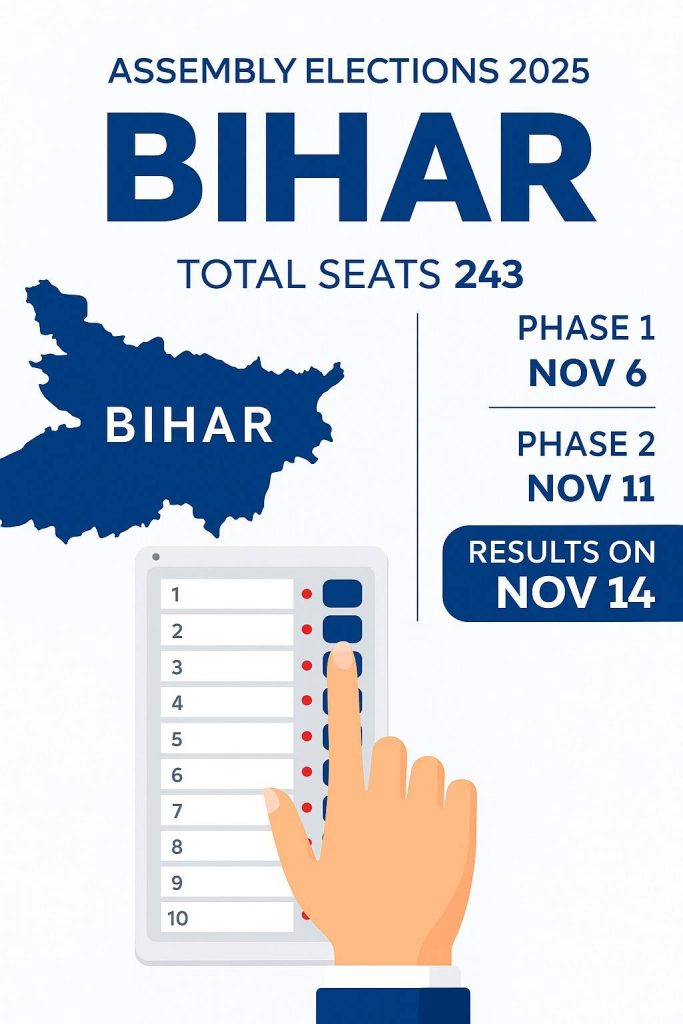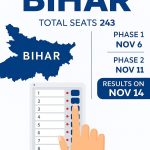Bihar Assembly Elections 2025: Dates, Key Issues, Parties and Predictions
As Bihar gears up for its Assembly Elections 2025, the state finds itself at a political, social and economic inflection point. With rising aspirations among youth, complex caste dynamics and shifting political loyalties, this election is more than just a contest of parties — it’s a litmus test for governance, identity and the promise of development.

Election Schedule & The Ground Situation
The polls will be held in two phases, on 6 November and 11 November. The counting of votes is scheduled for 14 November.
The Model Code of Conduct has come into force.
Voter rolls have undergone a Special Intensive Revision (SIR), which has led to a reduction in the number of registered voters, amid allegations of exclusion by opposition parties. About 7.42 crore electors are listed in the final roll, after deleting tens of lakhs of entries.
Main Players & Alliances
- NDA (National Democratic Alliance): Includes BJP, JD(U) and smaller allies. Nitish Kumar (JD(U)) remains a key figure. The NDA is leaning heavily on its governance record, welfare schemes, and infrastructure promises.
- Mahagathbandhan / INDIA bloc / Opposition: RJD under Tejashwi Yadav, Congress, Left parties, and others. They are focusing on youth unemployment, caste justice, reservations, and holding the ruling alliance accountable for alleged shortcomings.
- New Entrants / Other Parties: Prashant Kishor’s Jan Suraj Party is one to watch for potential vote splitting or as a kingmaker in close contests. Aam Aadmi Party (AAP) is contesting all 243 seats on its own, indicating its ambition to expand in Bihar.
Key Issues Dominating the Discourse
- Unemployment & Migration: Many young people migrate out of Bihar in search of work. Job creation, skill development, and industrial investment are seen as essential. Voters are demanding not just promises but visible action.
- Caste and Identity Politics: Bihar’s politics has always had caste at its heart. In 2025, caste-based concerns — whether about EBCs (Extremely Backward Classes), OBCs, Dalits, or backward quotas — are once again central. There are calls for a caste census and more inclusive representation.
- Welfare Measures & Governance:Welfare announcements—such as subsidised electricity units, pensions, quotas for women, etc.—are being deployed by the ruling side. The opposition is accusing the government of making election-time sops, while the incumbents argue that such schemes are part of long-term policy.
- Electoral Rolls & Voter List Revisions: The SIR process has become controversial. Opposition parties allege that many names removed disproportionately affect women, minorities, or marginalised groups. The Election Commission maintains it’s a procedural necessity to clean up rolls and remove ineligible voters.
- Development, Infrastructure & Basic Services:Voters are increasingly asking for delivery on ground—better roads, health facilities, schools, electricity, etc. Education and healthcare, especially in rural areas, remain weak spots.
- Anti-Incumbency & Leadership Perceptions: Leadership matters. The image of Nitish Kumar, Tejashwi Yadav, and other leaders (at state and local level) will likely influence outcomes. Surveys show that while NDA may have an organizational edge, Tejashwi Yadav is ranked highly in many polls as a preferred Chief Minister.
What Voters Are Saying (Surveys & Sentiments)
- In opinion polls, unemployment showed up as the top concern, followed by inflation, corruption and infrastructure deficits.
- Tejashwi Yadav has sometimes edged ahead as the public’s preferred CM in certain surveys, though the margin over Nitish Kumar isn’t huge.
Moneycontrol - There is apprehension among many in the public about the SIR process potentially leading to disenfranchisement.
Challenges & Uncertainties
- Predicting outcomes is hard given the fragmented nature of voter loyalty, especially among various caste groups.
- The role of “third front” players or independent candidates: they may not win many seats, but could influence who forms government in close calls.
- Data reliability: Surveys may under-represent rural/marginal areas. Voter issues may not always match what surveys show.
- Possible last-minute shifts: defections, alliances, candidate withdrawals, or emerging controversies (e.g. law & order, corruption) can swing sentiment.
Why This Election Matters Beyond Bihar
- Bihar, being one of India’s most populous states with significant socio-economic challenges, often acts as a bellwether: how governance, caste, reservations, welfare and identity politics play out here tend to echo in other states.
- The election results may feed into the larger national narrative of the INDIA vs NDA blocs ahead of future general elections.
- Demonstrates how electoral reforms (like voter roll cleanups) are being perceived and contested — with implications for democracy, inclusion and rule of law.
The 2025 Bihar Assembly Elections are poised to be among the most consequential in recent years. It’s not simply about which party wins, but about the type of governance Bihar wants. Development with dignity, identity politics with inclusion, welfare with accountability — voters seem more alert than ever to the gap between promise and performance.
For many, this election is an opportunity to demand more: better jobs, honest administration and respect for every citizen’s vote and rights. Bihar’s future after November will depend a lot on whether political actors meet those demands — not in speeches, but in action.































